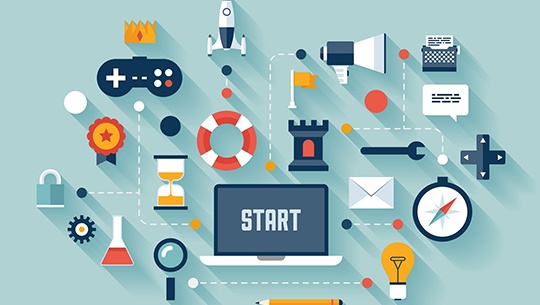Many developers of virtual simulations sooner or later wonder how to improve training performance. The answer that will be proposed today lies in the depths of human motivation and basics of the psychology of perception. This solution helped thousands of training to develop into effective practice based on a human's cognitive features. We are talking about learning through a game, of course. In general, gamification elements that are added to training scenarios usually bring game thinking and specific game mechanics into the learning process in order to provide a more engaging method of training. Even though it is not new to the industry, since it has been widely used for more than a decade now, most code engineers completely ignore it due to the fact that they are not aware of how to implement it. Reshaping the training with game features can help improve learning performance and scores, increase the level of motivation and engagement in the process, and enhance training value. In this article, which will be divided into three parts, our technical officers gathered already-existing examples of successful application of gamification and share their own suggestions on how to use it in virtual training.

Option 1: Simulate Complex, Real-Life Situations by Boosting Difficulty
This option can be applied from every kind of virtual training — from hostage saving practice for military organizations to the procedural training of a surgeon to corporate staff instruction. It is a quite common situation in virtual simulations when the training itself is based on lifelike circumstances, but made extremely sophisticated intentionally in order to test trainees' abilities and teach them how to behave in difficult situations. Besides, the simulation allows for creating a variety of scenarios with many features included. For instance, for the business environment, the training can be created based on the natural need for people to compete by motivating them to compete with colleagues to occupy the higher position.
Based on their performance, they can be promoted to specialist, manager, team leader, director or, if they failed to show acceptable results corresponding to the stated qualification, fined or even fired. At first sight, you may think it is inappropriate to put your employees in such harsh conditions; however, first of all, by introducing various challenges, you mimic real-life scenarios and give them an invaluable opportunity to prove themselves. As a bonus, your staff members can play against fellow workers and upper management. This case adds an extra motivator of peer pressure and team spirit with scores on a leaderboard.
Option 2: Feature Social Interaction
Successful training is aimed at absorbing the material by the users and the future application of the skills that they gained in real-life situations. Eventually, this is the most important training goal that every business professional wants to experience. Gamified elements allow for taking full advantage of virtual practicing. As one of the most prominent examples of how to include this ingredient in the educational process, we can consider the tool that empowers people to rapidly recover from a stroke. As it was stated in a Microsoft research blog a couple of years ago, the special program is designed for the healthcare industry with the help of Microsoft Kinect. It combines the elements of ordinary simulation that allow patients to practice simple activities within a safe environment to bring them back to the daily routines and gamification features that enable people to be involved in a competitive social environment. This unique blend provides a highly immersive, engaging, and, of course, a useful platform where patients perceive necessary exercise as a fun game, not as a tedious treatment, where they can earn skills and prizes, follow their progress, and compare their results with those of other patients whereby the recovery is going much faster. The example may seem old enough for you; however, the method of application is still relevant and, moreover, the technology it uses is gaining more popularity in the world.
Option 3: Help People with Learning Disabilities to Achieve Great Results
It is extremely important to develop training that considers the special needs of special people. The ones who have learning disabilities, for instance, Attention Deficit Disorder (ADD) or Attention Deficit Hyperactivity Disorder (ADHD), find it more difficult to concentrate on a certain activity and finish what they started. So, it is significant to take into consideration their necessities and establish an engaging virtual simulation that helps special people absorb a serious volume of information. Training that includes gamification elements provides an excellent platform that stimulates people who have problems with focusing on learning to capture their attention. It is favorable in both ways. First, it creates a strong mental connection between learning and playing that is actually quite challenging for individuals with concentration disorders. Second, it facilitates the learning process and increases the level of information retention. Do not discount people only because they have problems with mastering educational material; they simply need a special approach to the training.
The use of gamification for learning and development in the business context is a growing trend. Understand the potential of gamification in transforming the way your team learns and grows. Check out our white paper!
Option 4: Enhance an Actual Training Program
Most of the time developers want to improve existing training or develop a new one on the basis of what is already familiar. They want to explore the hidden potential of practicing and, for that reason, add some new essential features. Gamified elements are ones that should be considered. Let's take the administration training program as an example. By integrating gameplay, we want to help trainees develop the necessary set of skills to improve their performance as a team or corporate leaders. Such advanced practices include industry-oriented, real-life challenges and obstacles that they need to overcome to learn additional points, important choices to make in the workflow, and a list of achievements to accomplish in order to improve work efficiency.
Gamified training will be received extremely well by management staff, and the transformed simulation will provide engaging and compelling practice.
Option 5: Avoid Training in Dangerous Environments
This is a quite common use case for gamified training. Eventually, it is one of the main reasons why humanity uses virtual training - to avoid hazardous situations and practice the necessary skills within a safe environment. We all know that some surroundings may be rejected as a training platform because of the danger they may imply for an inexperienced community. Gamified elements such as acknowledgments, badges, leaderboards, and competitions can find their application mostly in military, government, and the industrial environment when the training is occurring under unpredictable conditions. Our expert team wants to share one catch with you on how to uniquely insert gamification features. As an unusual solution, we can advise you to generate new challenges and some "bonus tasks" randomly, as well as their level of difficulty. First of all, obtaining these achievements can prepare trainees for a variety of unplanned situations that can happen in the field and, also, the spontaneous nature of the challenges means that the reward for their overcoming is not predefined, making it more pleasant. Besides, it makes training more realistic and engaging, as it, just as in real life, is a struggle to succeed and help create innate motivation through the application of gamified features.
Option 6: Improve Corporate Training
Game-based training, as we have already figured out, can be useful anywhere because learning through playing is one of the most effective ways to mastery of a concept. However, many business owners wonder how can they use it for the sake of corporate growth and staff training? To be honest, virtual simulations with gamified components can be extremely useful in a corporate environment, especially in team building processes. But, here is one advice from Program-Ace experts: combine skill-based training, team building, and game in an extraordinary powerful mix so your business and corporate environment inside it will become more effective and friendly. How can you do that? Our main idea is to create some procedural training with gamification elements that help your employees develop specific skills necessary for good work performance. Then, initiate some time for talking where your staff members can share difficult situations where they failed to find appropriate solutions. A few weeks after, you can ask participants of the training to go through a short test that will include troublesome cases (the ones employees were incapable of settling on). Thanks to new techniques explained in the gamified training, your workers will be able to look at these cases at different angles and find another perspective approach to resolving the issue.
Option 7: Unusual Approach to Corporate Presentation
If we touched the case upon the subject of corporate learning, let us offer you some more incredible examples of how to inject gamified elements into the training process. Boring corporate presentations may be diluted with something fun and useful. For instance, you can use an audience response system (ARS) to collect all the possible detailed replies to an issue. You can ask an audience to utilize smartphones to send a text answer, so everyone can observe their answer choices versus other team members' responses. After everyone left their detailed responses, display the correct answer on the screen and explain it, so everyone will understand. This technique is useful for a couple of reasons. First of all, human beings learn better during the game (we will not get tired of repetition) and remember the correct answer better if they once answered totally wrong. In addition, it is a good way you turn an uninteresting presentation into something that can relax the audience by allowing them to laugh and have a little fun. Game-based elements keep the presentation entertaining as well as educational, and this is what we all are looking for.
If you want to learn more incredible use cases of gamification in learning, read the second and the third parts of this article, Gamification Elements in Training, Examples in Business and Trends, Techniques & Strategies.

























